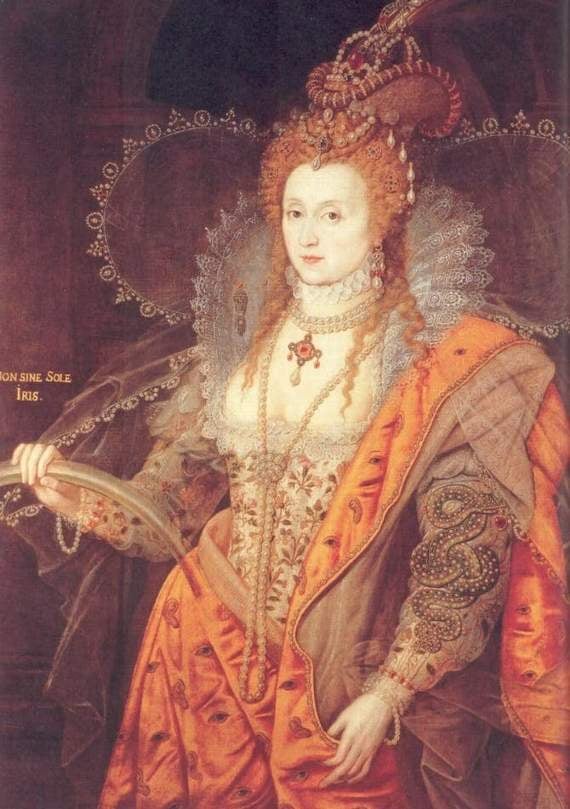QUEEN Elizabeth I was something of a clothes horse. She owned somewhere between 2000 and 4000 dresses. And that’s a lot of cloth by anyone’s standards.
Sadly, they were all destroyed by the wife of James I, who had no truck with such old hat, or sold off by a poe-face Oliver Cromwell who set no store by such foppish finery.
What this pair of cultural philistines didn’t destroy, went up in smoke, quite literally, as a fire raged through the royal wardrobe and destroyed the remainder of the ‘material girl’s’ treasured outfits.
For centuries students of historical fashion were left frustrated when it came to Tudor style. All they had to judge it’s true aesthetic merit on was a few dusty period paintings and a hat which was thought to have been once worn by Henry VIII.
Before the reign of Charles II almost nothing had survived in the form of royal garments.
So it was a real eye-opener when an altar cloth used in a parish church in Herefordshire was discovered to be a skirt once worn by the Virgin Queen.
Such a find raised a few eyebrows. In fact it has been described as ‘the Holy Grail’ of fashion history and it’s causing a right royal commotion.
“But how did it get there and what’s its relevance to Abergavenny” you cry? Well read on and let’s peer under the petticoats of this embroidered yarn.
Once upon a time there was a lady called Blanche Parry. Blanche was born in Bacton and would later become Queen Elizabeth’s companion and confidant for 56 years. She was Chief Gentlewoman of the Bedchamber and was in charge of the Queen’s jewels.
Her father owned lands around Llangorse Lake and one of her relatives is thought to have built the Gatehouse at Abergavenny Castle.
Blanche was fluent in Welsh and rumour has it that she was a key player in financing the first Welsh translation of the Bible.
Blanche had been a constant in the life of Queen Elizabeth I ever since the legendary monarch was a baby.
When Blanche died in 1590, aged 82, it’s thought the Queen honored the memory of her old friend by having one the royal skirts fashioned into an altar cloth and gifted to Blanche’s family church in Bacton, St Faith.
This was much more of a monumental gift than you might think.
In Tudor times clothing was very expensive. And when it comes to the Queen’s wardrobe you can chuck an extra few quid on top. The outfits were never discarded or put in a rubbish bag and dumped outside the nearest charity shop. No sir. In those days they made things to last and they made them well. The clothes were passed on through the generations, or recycled and reused for something else. Such as cushion covers.
Plus, the Tudor sumptuary law and basic finances forbade most people from wearing white or cream silk woven with silver. This was the prerogative of the blue-blooded. So to give such a gift was a rare blessing indeed.
The Blanche Parry Embroidery as Queen Lizzy’s old skirt has become known, was put in a dark box and stored for centuries at St. Faith by the Bacton clergy, who gave it the occasional airing.
In 1911, the Revd. Charles Thomas Brothers decided something of such historic importance needed to be put where all great works of art belong, on the wall.
Hung on the north wall of the church in a magnificent oak frame, the faithful were were able to view the skirt in all it’s glory. There was only one downside. You could still see the dazzling silk embroidery and intricate detail but at some point in history this breathtaking piece of work had been remorsefully cut up to fit a very small communion table by a less delicate hand than the skirt’s creator.
Nevertheless something of its original glory still shone through and it is this which caught the eye of author Ruth E. Richardson who has written a biography on Blanche Parry.
Ruth’s research also encouraged Abergavenny’s Eleri Lynn, curator of historic dress at Historic Royal Palaces to visit the 13th-century church and confirm the Blanch Parry Embroidery was the real deal.
Taken to Hampton Court Palace in 2015, the skirt is currently being restored to all its dazzling brilliance by a team of experts. It will take pride of place at a forthcoming huge exhibition on the private lives of the Tudors.
Ruth told the Chronicle, “The skirt is an international treasure and worth millions. It’s the only surviving piece of clothing from the wardrobe of Queen Elizabeth I, and it’s a miracle it survived all these years.
“In fact, when I wrote my book on Blanche, I purposefully underplayed the importance of the skirt because I was terrified someone would steal it. I was aware of its importance but thankfully at that time the rest of the world wasn’t. If they were, anybody could have just walked into the church and taken it from the wall. There’s no highly-trained specialist security teams at Bacton Church you know.”
Ruth added, “When they removed it two years ago, they used the same procedures as if they were handling a work by Leonardo De Vinci. It was placed in a freezer and as it turned out just in the nick of time too.”
Ruth explained that the cloth had been mounted on a background of green baize for the previous 106 years. The baize had become damp with time and the green colour had just started to seep into the skirt. Fortunately the damage was extremely limited.
Ruth explained, “Had it been left any longer we may have had a crisis on our hands. Which would have been a devastating loss. The skirt’s intricate design has so much to reveal. Silver and silk is extremely difficult to embroider upon, but the needlework is exquisite and the colour so vibrant. It really is a priceless work of art.”
Eleri Lynn first became aware of the skirt when studying the connection between the Tudor Court and Wales for a St David’s Day blog. Her research led her to an article on Ruth’s website(www.blancheparry.co.uk) which discussed the significance of the altar cloth at Bacton. Almost immediately she realised she was onto something special.
Eleri told the Chronicle, “When I visited St Faith in Bacton for the first time I had a bit of a ‘wow’ moment. Upon inspecting the cloth it felt like I had stumbled upon the Holy Grail, or the Mona Lisa of fashion.”
Although the evidence indicating that the Blanche Parry embroidery is the last surviving piece of clothing worn by ‘Good Queen Bess’ is, by the very nature of the beast, circumstantial, Eleri is convinced the cut and quality of the cloth are the real deal.
“All the experts who have looked at it have been overwhelmed by the quality of the work involved,” explained Eleri. “The workmanship and the historical facts surrounding the skirt point towards it once being owned and worn by Elizabeth.”
In fact it is not inconceivable that in the famous Rainbow portrait of Queen Elizabeth I from 1602, the fashion conscious monarch is wearing the skirt.
Although the skirt cannot be seen in the painting, the bodice worn by the famous figurehead bears a striking resemblance to the altar cloth.
Eleri explained, “People such as Ruth E. Richardson and the people of Bacton knew about the significance of the cloth which was hanging on the wall of their church for a long-time, but it was sort of a well-kept secret.
“Now that the significance of the cloth has been confirmed, St Faith have kindly agreed to loan it to us so we can carry out vital preservation work.”
It is estimated it will take two-full time workers over 18 months and thousands of hours to restore the skirt to its former glory. Once accomplished the rest of Britain and the world will be able to marvel at the skirt once worn by the woman once known as Gloriana, the Virgin queen and the last monarch of the Tudor dynasty.
Like Queen Elizabeth’s reputation, the skirt has stood the test of time and in Eleri’s words has become a “National treasure.”





Comments
This article has no comments yet. Be the first to leave a comment.